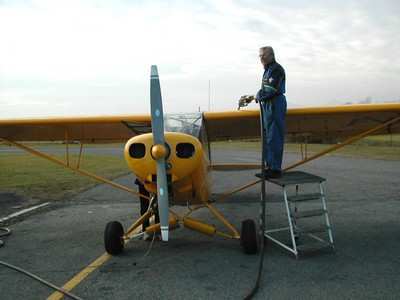Sat, May 30, 2020
EAA Made Clear That The Public Has Limited To No Exposure To EDB In Concentrated Form
EAA recommended the EPA not designate an integral component of avgas, ethylene dibromide (EDB), as a high-priority substance for future study and regulation to avoid profound safety of flight and economic implications that would result from potential control or limitation on EDB, which could effectively limit or eliminate the continued availability of leaded high-octane avgas.

EDB is used as the scavenger for lead in avgas and makes up one of the two major components of the octane-enhancing, lead-additive package used in avgas production called TEL-B, which is principally made up of tetraethyl lead and EDB. Any future efforts to regulate EDB in aviation gasoline under the Toxic Substances Control Act could have the same effect as regulating lead, with serious implications for general aviation. There is no immediate threat to the supply of leaded aviation gasoline, and the current EPA activity to evaluate up to 40 chemicals for prioritization for study and possible future regulation is the first in a multistep process that is likely to take years if it goes forward for EDB at all.
EAA has played a key role through the joint industry/government effort known as the Piston Aviation Fuels Initiative (PAFI) in working to advance the research, development, and eventual FAA authorization of an unleaded aviation gasoline to replace the high-octane leaded gasoline upon which much of the piston-powered general aviation fleet is currently reliant.
Until a time where a safe, operationally effective, and economically viable unleaded replacement is available, TEL-B, and therefore EDB, are necessary components of the avgas the GA fleet requires to operate.
In its comments, EAA made clear that the public has limited to no exposure to EDB in concentrated form for aviation use. EDB is not manufactured in the United States and is only imported from the U.K. as part of the TEL-B lead additive, where it is delivered in sealed containers to the handful of refiners and blenders producing avgas in the U.S. TEL-B is then blended with bulk fuel components in enclosed systems before being distributed for sale. EDB makes up less than one-tenth of one percent of finished avgas by weight.
EAA submitted comments with its stated position early this week, and continues to maintain the development of a future unleaded replacement for 100LL as one of the organization's top priorities.
More News
A Puff Of Smoke Came Out From The Top Of The Engine Cowling Followed By A Total Loss Of Engine Power On May 9, 2025, about 1020 mountain daylight time, an experimental amateur-buil>[...]
From 2022 (YouTube Edition): Jenny, I’ve Got Your Number... Among the magnificent antique aircraft on display at EAA’s AirVenture 2022 was a 1918 Curtiss Jenny painstak>[...]
Very High Frequency (VHF) The frequency band between 30 and 300 MHz. Portions of this band, 108 to 118 MHz, are used for certain NAVAIDs; 118 to 136 MHz are used for civil air/grou>[...]
“From approximately November 2021 through January 2022, Britton-Harr, acting on behalf of AeroVanti, entered into lease-purchase agreements for five Piaggio-manufactured airc>[...]
Microburst A small downburst with outbursts of damaging winds extending 2.5 miles or less. In spite of its small horizontal scale, an intense microburst could induce wind speeds as>[...]
 NTSB Prelim: Lee Aviation LLC JA30 SuperStol
NTSB Prelim: Lee Aviation LLC JA30 SuperStol Classic Aero-TV: Curtiss Jenny Build Wows AirVenture Crowds
Classic Aero-TV: Curtiss Jenny Build Wows AirVenture Crowds ANN's Daily Aero-Term (05.30.25): Very High Frequency (VHF)
ANN's Daily Aero-Term (05.30.25): Very High Frequency (VHF) Aero-News: Quote of the Day (05.30.25)
Aero-News: Quote of the Day (05.30.25) ANN's Daily Aero-Term (05.31.25): Microburst
ANN's Daily Aero-Term (05.31.25): Microburst



